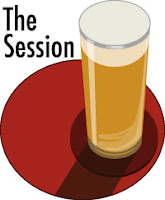 I spoke
I spoke a bit too soon when I complained that there hadn't been many new DOT beers in my line of sight this year so far. Before that was even published, there were four more to add to my to-drink list, all of them thanks to DOT's assorted pals and partners.
First up, a rum/whiskey barrel-aged Helles? Did you ever hear tell of such a thing?
Helles Yeh! is the latest in the collaboration series between DOT and the Teeling Whiskey distillery, and sold exclusively through its giftshop in Dublin. It's kellerbier hazy and smells a little like dry crackers and faintly of oaky spirit, with perhaps a little more of rum's sweetness than whiskey's. The mouthfeel brings us back to classic Bavarian lager: it's properly smooth and very clean, opening with a crisp grain crunch followed by softer honey and spongecake. It's only 5% ABV but doesn't really use that to deliver big flavours, and I feel a little gypped by how little it tastes of the barrels: you need to dig right in to the back to find a thin patch of oak and spirit. It's decent drinking, though, and comes across as a better example of Helles than I thought it was going to be. But at €6* for a small can, I feel it did owe me more complexity. Or a bigger can.

We switch retail partners for the next one, another in DOT's
Spin Off Series for Aldi:
Oatmeal IPA. This is 5.8% ABV and a mostly-clear golden colour, suggesting the west coast of America more than it does a bowl of porridge. The head was a little slow to form, so condition was the first thing I was on alert for. No problems there: it's lightly carbonated, which helps the oatmeal smoothness do its thing, resulting in something that resembles the mouthfeel of a nitrogenated beer without being one. I found the hop side a little bit lacking, with only a vague piney acidity at work in both the aroma and flavour. We're promised "juicy fruity Simcoe" (is that a thing?) by the label, but the beer does very little to back up this promise. The flavour is primarily built around cereal flavours, dry and flaky. On one hand that shouldn't be a surprise with oatmeal, but equally, oatmeal IPAs never taste of the actual oats: that's not the point. I also get a very slight soapy twang on the finish. I don't know where that came from, but it could have been covered up with more hops. This is a compromised affair which will doubtless shift units, and if that helps keep the brewery lights on, all to the good. It's not DOT's best work in the hop-forward space, however.

Back to the barrels, and the next two are continuations of the barrel-aged imperial milk stouts that DOT has created with Two Sides, the beer brand of Brickyard in Dundrum.
I confess I haven't been keeping fully up to date with these, and the pair starts on
Over A Barrel 06: Blend Whiskey Ex Blackberry Brandy. Whiskey support here comes from Two Stacks rather than the more usual Teeling. One doesn't expect much of a head from barrel-aged beer, but this had a full-sized pillow of beige foam over the shiny black body. It's blackberries a-go-go in the aroma; smelling of all the mushed forest fruits in quite a yoghurt-like way. It only becomes a little more stout-like in the flavour, and the fruit is still fully infusing it, building up to a surprisingly intense perfumed finish. Before that, the milk stout presents in quite a typical way, with creamy milk chocolate, plus hints of vanilla and latte. It's only 9% ABV, so badging it as "imperial" rather than, say "export" is a bit of a liberty, and the flavour reflects this understatedness. A growing alcoholic warmth in the belly is the only real sign that it has welly. There's a decent beer in here, but the blackberry brandy gives it too much blackberry, almost like they've simply dumped in some syrup. Give me more stout, please.

That request is directed at
Over A Barrel 07: Single Malt Ex Maderia [sic], which sounds altogether more grown up. There's less of a head here, and the aroma is definitely all whiskey: the crunchy honeycomb candy of the Irish sort, at once sweet and seriously boozy. "But the Madeira," you ask, "Where's the Madeira?" That's present from the very beginning of the flavour, as a kind of coconut sweetness with an edge of raisin and booze. You know, Madeira. Once again, stout is not the principal characteristic, and you have to go looking for it. There's a certain amount of creamy chocolate, but it's buried under the mix of whiskey and wine, like some sort of temperance metaphor. While the previous one tasted innocent for its 9% ABV, this one is full-on barrels and spirits and the rest. It's fun, and provides everything one would expect from the spec. Brewers don't often barrel-age milk stouts, and this one shows how it should be done. No blackberries.
DOT will soon be celebrating nine years in business. They've decided some re-brews are in order, but maybe we'll get something new as well.
*Compliance with the law on drinks packaging is for the little people, not Teeling. They don't charge deposits on the DOT cans, though they are returnable, so the net cost of this one was a mere €5.85.


































